John Clark and Adam Hollis1
This article will analyse the structural and cyclical factors affecting past and expected future Australian Government tax receipts. As a share of the economy, taxes are expected to remain well below the levels of the mid-2000s.
Introduction
Since the early 2000s, the Australian economy and hence tax collections have undergone large structural and cyclical changes. After increasing to record highs and then falling to its lowest point since the early 1990s recession, the tax-to-GDP ratio is expected to recover to slightly above its long-run (30 year) average by 2014-15, but will remain below its pre-Global Financial Crisis (GFC) highs, notwithstanding continued solid real economic growth.
This article will analyse the structural and cyclical factors affecting past and future Australian Government tax receipts.
One component of the lower tax-to-GDP ratio is cyclical, primarily where high prices in equity markets and commodities helped increase the ratio to unprecedented levels in the mid-2000s. These prices subsequently fell, particularly during late 2007 and 2008, generating a large decline in the ratio which has extended at least until 2013. Given that these prices are not expected to rise so quickly again in the foreseeable future, capital gains tax receipts as a share of GDP are expected to remain substantially lower than in the mid-2000s.
The other component is structural, through the changing composition of the tax base through both explicit government policy (such as large personal income tax cuts, increased concessional treatment of super, the non-indexation of fuel excise and specific narrowing of the corporate tax base largely designed to reduce the tax burden on foreign investment), and the changing composition of the economy to more reliance on the capital intensive resources sector.
These structural and cyclical factors have been of interest for many years and will significantly impact fiscal strategy over the next decade and beyond.
Tax-to-GDP ratio
The ratio of tax-to-GDP is often used as a measure of tax paid which can be compared across years. GDP is a useful comparator for tax because most tax bases are related to economic activity, and an increase in economic activity will generally result in an increase in tax (and a decrease in activity will result in a decrease in tax). Through the 2000s, the Australian Government tax-to-GDP ratio first rose to its record high of 24.2 per cent, before falling during the GFC. The tax-to-GDP ratio has fallen during previous economic downturns; however, the severity of the fall experienced during the GFC and its longer term implications are for the most part unprecedented. From its pre-crisis level in 2007-08, the tax-to-GDP ratio fell 3.7 percentage points (around 16 per cent) to 20.0 per cent in 2010-11, the biggest decline in the ratio since the mid-1950s.2
Figure 1: Tax-to-GDP ratio
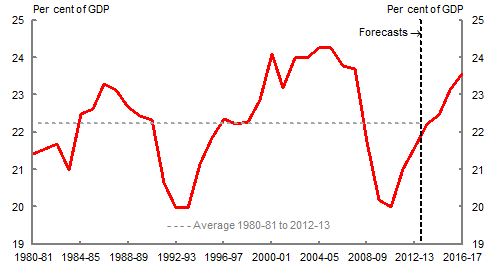
Source: PEFO 2013 and Treasury.
The GFC adversely affected all heads of revenue, as it affected all aspects of the economy — production, consumption, profits and employment. While taxes have been recovering since the post-crisis trough, the recovery in tax receipts has not matched that of nominal GDP. Even though nominal GDP had recovered by 2010-11 to the level projected at the 2008-09 Budget — the last Budget before the crisis — tax receipts in 2012-13 were well below their pre-crisis projection levels (see figure 2).
Figure 2: Change in GDP and tax receipts estimates
Nominal GDP
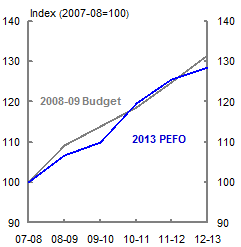
Tax receipts
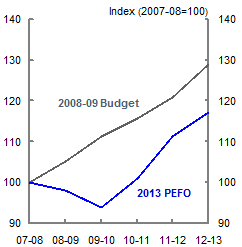
Source: PEFO 2013 and Treasury.
When economic conditions deteriorate, tax receipts generally fall by a greater percentage than the decline in the economy (and rise by a greater percentage in an upturn). Contributing factors include the progressivity of personal income tax, capital gains tax behaviour and the tendency of the tax system to tax volatile components of GDP rather than the more stable components.3 In the case of 2008-09 to 2010-11, other factors contributing to the decline include a series of consecutive income tax cuts for individuals and a long run decline in indirect taxes as a share of GDP. As an economy recovers from a downturn the tax-to-GDP ratio tends to rebound. The tax-to-GDP ratio was 21.6 per cent of GDP in 2012-13, a rise of 1.6 percentage points (around 8 per cent) relative to 2010-11 levels as a share of the economy (see figure 1). The rebound is partly a function of timing features within the tax system (mainly related to company tax) as tax receipts rise by a greater percentage than the change in the economy.4
The ratio is estimated to recover to its long-run average of around 22.2 per cent of GDP by 2013-14. The ratio increases to 23.6 per cent by 2016-17, slightly higher than the average over the last 30 years, but still below its 2000-01 to 2007-08 average of 23.9 per cent. The lower tax-to-GDP ratio is in part due to an unwinding of some of the factors that characterised the pre-crisis period. Very strong capital gains tax (CGT) receipts owing to steep rises in equity prices and a maturing CGT system, rapidly rising commodity prices, rapid credit growth, and a low household savings rate are not expected to be repeated in the post-crisis period. Further, some of the weaker recovery in tax receipts relative to the economic recovery is due to a structural erosion of the tax base.
Key factors contributing to the evolution of tax receipts over the past decade, as well as factors constraining a return to the pre-GFC tax-to-GDP ratio in the future, are discussed in turn. This article will focus on the main elements of the Australian Government tax system: income tax, both personal and company, a separate discussion on CGT, and finally, indirect taxes.
Personal income tax
Income tax withholding (ITW) is the primary form of taxation on wage income.5 ITW fell significantly as a share of GDP between 2004-05 and 2009-10 (see figure 3). This was largely structural, driven by a succession of personal income tax rate reductions. Taxes on wages fell from 10.4 per cent of GDP in 2003-04 to 9.2 per cent of GDP in 2010-11, a decrease to the tax-to-GDP ratio of around 1.2 percentage points (11 per cent). The ITW-to-GDP ratio is forecast to approach the level from before mining boom mark I (2003-04 to 2007-08) in 2014-15. While the falls in ITW as a share of GDP contributed to the falls in total tax as a share of GDP between 2007-08 and 2010-11, it was relatively small. ITW contributed around 0.5 of the 3.7 percentage point (around 13 per cent) fall in the tax-to-GDP ratio between 2007-08 and 2010-11.
Figure 3: Income tax withholding-to-GDP
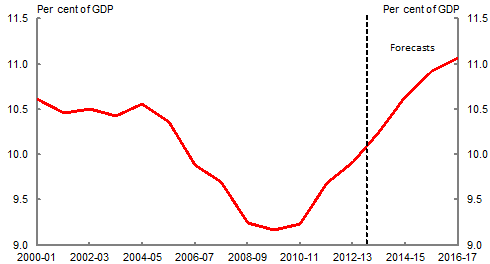
Source: PEFO 2013 and Treasury.
Between 2003-04 and 2010-11, a succession of cuts to personal income tax rates reduced the average rate of personal income taxation. The average rate fell from 24.3 per cent of taxable inco me in 2003-04 to 21.2 per cent of taxable income in 2010-11, a fall of around 3.1 percentage points. The average rate is expected to increase as bracket creep — a feature of a non-indexed progressive taxation system — driven by wage inflation moves individuals to higher average tax rates. The tax cuts through this period were significantly more than what was required to return bracket creep, as illustrated by the size of the fall in the average rate. Whilst providing tax relief for individuals, the succession of tax cuts beyond returning bracket creep structurally changed the personal income tax base relative to levels observed in the early 2000s. The average tax rate is not expected to approach 2003-04 levels until around 2016-17 (see figure 4).
Figure 4: Average rate of personal income taxation (income-year basis)

Source: Treasury.
Wages declined as a share of the economy in the decade preceding the GFC (see figure 5) and this also contributed to the decline in ITW relative to GDP. However, the decline in the tax-to-GDP ratio was primarily due to the sustained tax cuts highlighted above.
Figure 5: Wages as a share of GDP (factor cost)
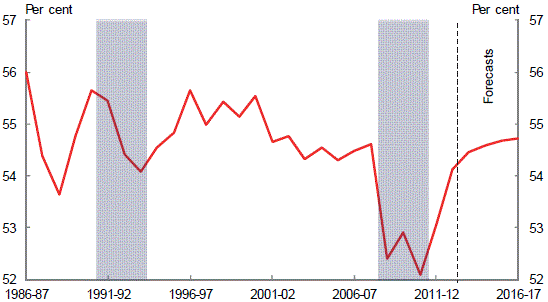
Source: ABS 5206.0 National Accounts and Treasury.
Interestingly, the movements in the wage share during the GFC were different to the 1990-91 recession. During an economic downturn the wage share normally increases as business profitability falls. Only after the downturn becomes entrenched do businesses shed labour, such that the wage share falls back. The decrease in the wage share in 2008-09 is consistent with a decline in working hours during the GFC rather than a decline in employment.
Following the introduction of the superannuation guarantee, a share of wage income has been taxed at the concessional rate of 15 per cent. While the concessional rate has generated less tax than what would have been the case had the income been taxed at marginal personal rates, the share of wage income being diverted to superannuation has not changed markedly since 2000-01. The concessional tax rates on this component of employee compensation have therefore not been a significant driver of the reduction in the tax-to-GDP ratio over the past decade.
Company tax
Company tax, another source of income tax, is levied at a fixed rate (from 2001-02 at 30 per cent) on taxable company profits. The ratio of company tax receipts to GDP over the forward estimates is expected to soften relative to mining boom mark one levels (2003-04 to 2007-08), but remains significantly higher than its long term average.
Figure 6: Company tax to GDP
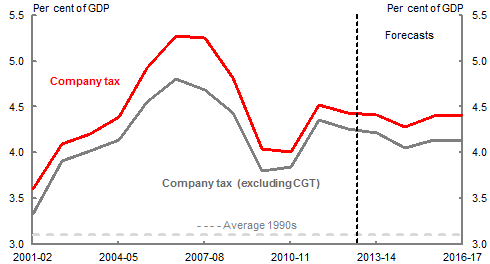
Source: PEFO 2013 and Treasury.
Company tax (excluding CGT) peaked during mining boom mark one, rising from an average of 3.1 per cent of GDP over the 1990s to 4.8 per cent in 2006-07. This high point largely reflected gains to the mining industry from high commodity prices. As the exchange rate simultaneously increased from US$0.59 in 2003 to US$0.96 in 2008, profitability in many other corporate sectors weakened. As the GFC hit, corporate profitability fell rapidly, with corresponding falls in corporate tax liabilities as a share of GDP. Company tax (excluding CGT) fell from 4.7 per cent of GDP in 2007-08 to 3.8 per cent of GDP in 2009-10, a fall of around 20 per cent. Following the GFC, company tax (excluding CGT) recovered strongly in 2011-12 to be around 4.4 per cent of GDP.
Despite this resurgence in growth, company tax (excluding CGT) receipts in 2012-13 as a share of GDP remained around 0.4 percentage points (9 per cent) below 2007-08 levels. Weaker commodity prices and the persistently high Australian dollar, which has put pressure on domestic prices, have hit company profits across most of the economy, including the resources sector.6 Company tax (excluding CGT) is forecast to be around 4.1 per cent of GDP in 2016-17. These forecasts are significantly higher (around 30 per cent) than the 1990s average of around 3.1 per cent of GDP. Investment in the mining sector and consequent large capital deductions are expected to have a prolonged dampening impact on receipts growth over the next few years.7
Trends in company tax can be better linked to the economy by abstracting from payment system effects and considering the tax on an income-year basis. This approach assigns the tax to the year in which the income was earned, rather than the 'cash' system where the tax is recorded in the year the liability was paid. The disadvantage of this approach is that income-year tax data comes with a significant lag and can be accurately determined only for 2010-11 and earlier.
Figure 7 shows company tax (excluding CGT) on an income-year and cash basis. The cash amounts generally 'lag' the income-year amounts as the payments are made some time after the income is earned. During the GFC the cash amounts fell further than the income-year amounts, as described above. The ratio of company tax to GDP increased steadily until its peak in 2006-07, before falling markedly, partly due to the GFC.
Figure 7: Company tax: income-year and cash basis
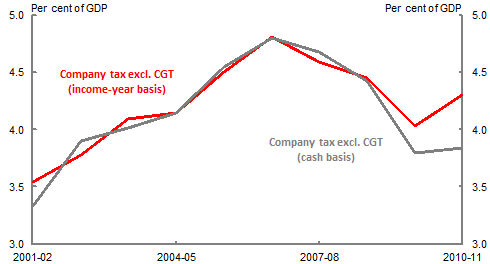
Source: Treasury
The main reasons for the rise and fall are threefold. Firstly, the company tax income base increased as a share of GDP over the 2000s, and remains close to historical highs, even post GFC. A useful measure of the company tax base is net operating surplus (NOS), a National Accounts derived amount equal to gross operating surplus (the National Accounts measure of corporate profits) less consumption of fixed capital (the National Accounts measure of economic depreciation). NOS-to-GDP can be seen in figure 8. Company tax broadly follows NOS in history. The increase in the ratio of NOS-to-GDP is consistent with growth in the profit share of GDP.
Figure 8: NOS-to-GDP
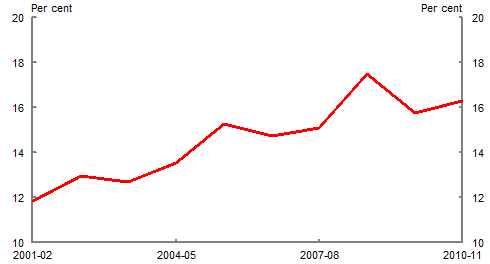
Source: ABS 5206.0 National Accounts and Treasury.
Secondly, the composition of the company tax income base has changed over time. Ten years ago the mining sector contributed less than 20 per cent to the company tax income base (see figure 9a). By 2010-11, the mining sector contributed around 37 per cent of the company tax income base. Over the same time, the financial sector has made a relatively consistent contribution to the company tax income base, while the share from everything else has fallen.
The changing shares are important for company tax collections because the mining and 'other' sectors each have stable but different rates of tax collections compared to their income bases. The rates are shown in figure 9b below. The different rates do not necessarily mean that the different sectors are not paying the appropriate amount of tax. Rather, the different rates reflect the extent that the mining sector utilises, for example, particular capital deductions or deductions for state royalty payments. Nevertheless, the different rates of tax mean that as mining's share of the economy increases, the resultant company tax wi ll decrease for the same amount of GDP. If GDP in 2010-11 had the same shares of corporate income from 2001-02 to 2003-04, then company tax for the 2010-11 income-year would have been over $5 billion higher, all else being equal.
Figure 9a: Industry shares of NOS
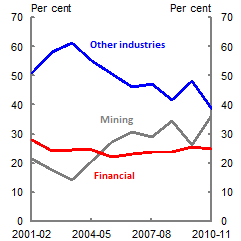
Figure 9b: Company tax-to-NOS ratio
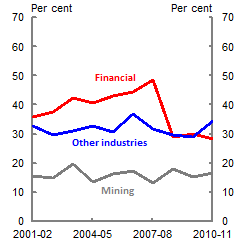
Source: Treasury.
Given that mining's share of the economy is likely to continue to increase as the sector moves from the 'investment phase' to the 'production phase', this effect may continue into the future. Potential large increases in capital deductions following the investment phase may exacerbate the effect further.
The third reason for the rise and fall in the company tax-to-GOS ratio is the GFC. The GFC had a marked effect not only on CGT, as discussed below, but also on the financial sector more generally, where the ratio of tax to the company income base fell from highs of around 45 per cent in the mid-2000s to around 28 per cent by 2010-11. The high ratio reflects the fact that a significant amount of corporate income in the financial sector is unrelated to GDP. For example, for companies whose core business is financial asset trading, these amounts are not recorded as capital gains but as normal operating revenue. These companies suffered heavy losses from the falls in global share markets starting from late 2007, which are reflected in the decline in the ratio of financial industry tax to economic income.8
Unlike the recent decline in corporate tax due to the changing composition of corporate income (see figure 6), this decline is likely to reverse somewhat over the next few years as losses are used up and asset prices grow. The ratio is not, however, expected to return to the heights of the pre-GFC period.
Capital gains tax
Capital gains tax (CGT) is paid by companies, individuals and superannuation funds on the realisation of assets held. CGT is not itself a separately identifiable tax, rather, a net capital gain, which can be realised by companies, individuals and superannuation funds, is a component of taxable income. CGT is calculated by applying the taxpayer's average tax rate to their net capital gains income.9
Figure 10: CGT-to-GDP
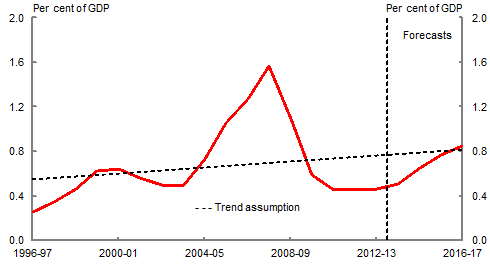
Source: PEFO 2013 and Treasury.
CGT peaked at 1.6 per cent of GDP in 2007-08, driven by strong asset price growth in the period before the GFC. The ASX 200 index had risen rapidly to around 6800 in October 2007. Had CGT remained at 1.6 per cent of GDP, CGT would be around $17 billion higher in 2012-13 (or 1.1 per cent of GDP).
The trend line shown in figure 10 represents a hypothetical amount of CGT generated from constant growth in relevant asset prices. The mild upward trend is due to the ongoing maturing of the CGT system.10 The trend line provides a useful simple method to isolate the structural and cyclical components of the CGT collections base. Assuming the trend line is an underlying 'steady state', 2005-06 to 2007-08 represented a period of above trend CGT collections driven by surging equity prices. CGT dipped to 0.4 per cent of GDP in 2010-11 following the GFC. The ratio of CGT to GDP in 2012-13 is estimated to remain around 0.3 percentage points (40 per cent, or over $5 billion) below underlying trend estimates.
This data illustrates how much tax receipts were temporarily inflated by between 2005-06 and 2007-08 due to the asset price boom. At the peak, CGT was contributing around 0.9 per cent of GDP to tax receipts above what would have been expected under long-run conditions in asset markets.
Over the forecast period, even as equity prices recover, other factors will continue to subdue CGT receipts. A significant stock of capital losses were generated during the GFC, which will continue to supress CGT receipts growth over the near term. The stock of capital losses more than doubled from $104 billion in 2007-08 (8.8 per cent of GDP) to $260 billion in 2008-09 (20.8 per cent of GDP). The stock of losses was around double the average over the period 2000-01 to 2007-08.11 Looking forward, despite these dampening factors CGT is expected to increase significantly as a share of GDP — although still small in relative magnitude — as the stock of losses is absorbed and the ASX 200 rebounds in the long run. However, the CGT ratio is not expected to reach the heights of 2007-08 and is unlikely to reach its underlying trend at least until 2016-17.
In addition to CGT, a significant amount of tax is paid on income earned by businesses engaged in financial asset investing on their own behalf, as their core business operations. Most of this income is not reported as capital gains for tax purposes but as ordinary income or expenses. This income is also likely to have fallen during the GFC. The tax associated with this income should be accounted for in determining the effect of the asset price movements on the tax-to-GDP ratio, but calculating the precise amount is difficult from available tax return data.12
Figure 11: Tax-to-GDP ratio
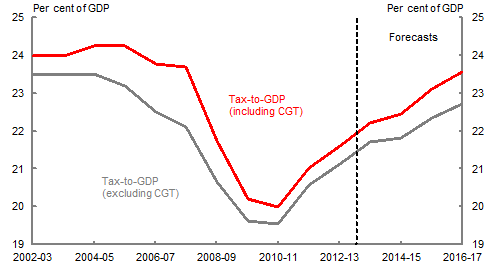
Source: PEFO 2013 and Treasury.
CGT receipts temporarily boosted the tax-to-GDP ratio from the early-2000s to 2007-08. Abstracting from CGT, the tax-to-GDP ratio fell steadily for six consecutive years between 2004-05 and 2010-11 (see figure 11). These falls were driven by both structural factors, as discussed above and below, and the onset of the GFC.
Indirect tax
Indirect taxes are a form of tax that increases the price of goods (or services) so that consumers are essentially paying the tax by paying more for the products they consume. Indirect tax collections (excluding goods and services tax (GST) and the effect of the carbon pricing mechanism (CPM)) have fallen from 3.8 per cent of GDP in 2000-01 to 2.5 per cent of GDP in 2012-13, a fall of around 1.4 percentage points (around 35 per cent). Structural factors surrounding alcohol, fuel and tobacco excise as well as customs tariffs have contributed to this long run decline. We have not discussed the GST, as these receipts are collected by the Australian Government on behalf of state and territory governments.
Figure 12: Indirect tax to GDP (excluding GST and CPM)
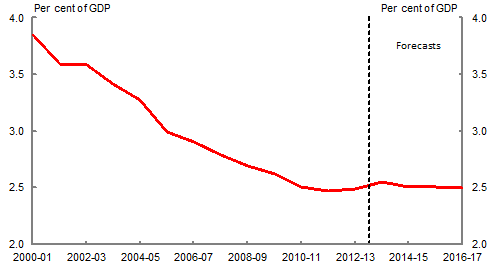
Source: PEFO 2013 and Treasury.
Fuel and petroleum products
A 2001 policy change resulted in the cessation of indexation of fuel excise rates. This change is the largest contributor to the structural deterioration of the indirect tax base. In real terms the level of fuel excise is reducing over time. Fuel excise was already falling as a proportion of nominal GDP in the lead up to 2001 (fuel excise receipts were growing slower than nominal GDP), but the end of indexation accelerated this decline. As illustrated in figure 13, fuel excise receipts fell from 1.8 per cent of GDP in 2000-01 to 1.2 per cent of GDP in 2012-13, a fall of around 0.6 percentage points (around 34 per cent).
Figure 13: Fuel excise to GDP
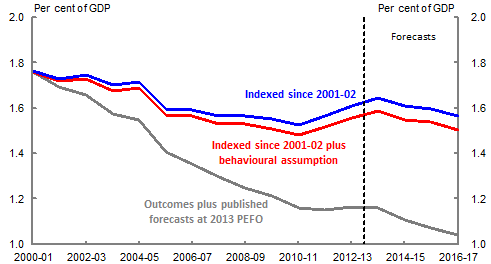
Source: Treasury.
Looking forward, fuel excise receipts are estimated to fall from 1.2 per cent of GDP in 2013-14 to 1.0 per cent of GDP by 2016-17, a further fall of around 0.1 percentage points (around 10 per cent). Hypothetically, had fuel excise indexation continued and given fuel is inelastic; collections would be around $6.7 billion higher in 2013-14.13 This estimate increases over the forecast horizon, as nominal GDP grows, rising to approximately $8.4 billion for the 2016-17 financial year.
Alcohol
As different rates of tax apply to different types of alcohol, the amount of tax collected varies both with aggregate consumption and the pattern of consumption, particularly between beer and wine. Alcohol consumption per capita remained largely unchanged between 2001-02 and 2011-12, but there was a noticeable change in the type of alcohol consumed. Figure 14 shows a clear move away from beer consumption towards the consumption of wine.
Figure 14: Alcohol consumption per capita
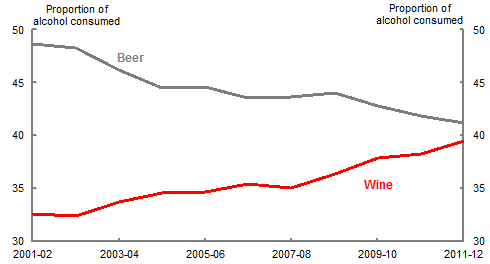
Source: ABS, Apparent Consumption of Alcohol, 2011-12 and Treasury.
The consumption of beer has fallen as a portion of total alcohol consumption per capita. Beer has an excise rate which is indexed bi-annually. Beer consumption was 48.7 per cent of alcohol consumed in 2001-02, falling to 41.2 per cent in 2011-12, a fall of around 7.5 percentage points (around 15 per cent). Wine consumption was 32.6 per cent of all alcohol consumed in 2001-02, rising to 39.5 per cent in 2011-12, a rise of around 6.9 percentage points (around 21 per cent).14 Wine is subject to the wine equalisation tax (WET), a tax on wholesale value as opposed to alcoholic content. The consumption of spirits has remained broadly unchanged at around 20 per cent of alcohol consumption.
The notable change in consumption has implications for Australian Government revenue. Taxes on alcohol have fallen from 0.43 per cent of GDP in 2006-07 to 0.39 per cent of GDP in 2012-13, a fall of around 0.04 percentage points (around 9 per cent).15 Alcohol collections are growing slower than nominal GDP growth and consequently have become an incrementally smaller component of GDP. Hypothetically had alcohol receipts remained at 2006-07 levels as share of the economy (0.43 per cent of GDP), alcohol collections would be around $580 million higher in 2012-13.16
Tobacco
Consistent with a long run decline in smoking rates, tobacco receipts have fallen as a proportion of GDP. Australian Taxation Office tobacco collections have fallen from 0.50 per cent of GDP in 2006-07 to 0.31 per cent of GDP in 2012-13, a fall of around 0.19 percentage points (around 39 per cent), despite a 2010-11 Budget decision in 2010 to increase excise on tobacco products by 25 per cent.17
Customs duties
Successive Australian Governments have reduced customs tariffs, which have also contributed to a decline in the indirect tax base.18 More recently tariff collections have fallen from 0.26 per cent of GDP in 2006-07 to 0.18 per cent of GDP in 2012-13, a fall of around 0.08 percentage points (around 32 per cent). From 1 January 2015, the tariff rate on clothing and finished textiles will be reduced from 10 per cent to 5 per cent, further reducing customs receipts as a proportion of GDP. Despite tariffs declining as a share of the Australian Government revenue base, lower customs duties are expected to have positive economic benefits more broadly.
Conclusion
The rise and fall of the tax-to-GDP ratio during the 2000s was due to a combination of cyclical and structural factors.
There has been a significant change in the composition of taxes as a share of GDP, relative to 2001-02 levels, illustrated in figure 15. Receipts from income tax withholding (ITW) as a share of the economy fell significantly between 2004-05 and 2010-11, largely due to a series of personal income tax rate cuts beyond returning fiscal drag, ITW receipts are not expected to approach the levels of the early 2000s until 2014-15. The recovery in the tax-to-GDP ratio is largely driven by ITW receipts increasing as a share of GDP. Company tax (excluding CGT) and CGT receipts peaked during the mid-2000s, they are both expected to stabilise as a share of GDP over the forward estimates, but will remain below the levels of the mid-2000s. Indirect taxes have fallen significantly as a share of GDP, as the non-indexation of fuel excise has resulted in fuel excise receipts growing slower than nominal GDP.
This analysis has shown that the peak in the tax-to-GDP ratio was underpinned by temporary, higher incomes from the high terms of trade and share market prices. The decline in the tax-to-GDP ratio since 2007-08 is partly due to an unwinding of those factors, and partly due to the changing composition of the economy and policy decisions in personal income tax and indirect tax (with indirect tax remaining on a long run structural decline).
Figure 15: Change in tax-to-GDP ratio composition
(relative to 2001-02 levels)
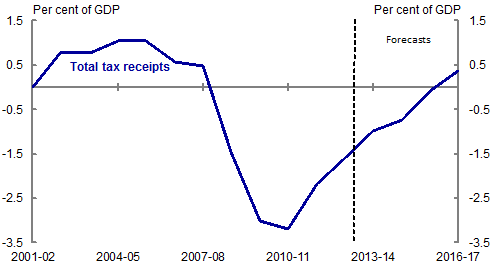
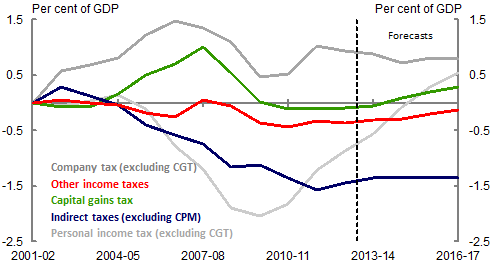
Source: PEFO 2013 and Treasury.
References
Australian Bureau of Statistics. Apparent Consumption of Alcohol, Australia, 2011-12. Catalogue 4307.0.55.001. Retrieved from http://www.abs.gov.au/ausstats/ abs@.nsf/mf/4307.0.55.001/.
Australia's Future Tax System. (2009). Final Report: Part 2 — Detailed Analysis — Volume 2. Retrieved from http://www.taxreview.treasury.gov.au/content/ Content.aspx?doc=html/pubs_reports.htm.
Australian Government Budget Papers, various years. Retrieved from http://www.budget.gov.au/.
Breunig, R & Gisz, C 2008, 'An exploration of Australian petrol demand: unobservable habits, irreversibility, and some updated estimates', Treasury Working Paper, 2008 — 2, pp. 1-28. Retrieved from http://archive.treasury.gov.au/documents/1460/PDF/ Australian_Petrol_Demand.pdf.
1 The authors are from Tax Analysis Division, the Australian Treasury. This article has benefited from comments and suggestions provided by Angela Baum, Roger Brake, Hayden Dimes, Carol Gisz, Alexander Kelly, Amy Leaver, Timothy McGuire and Jyoti Rahman. The views in this article are those of the authors and not necessarily those of the Australian Treasury.
2 The Australian System of National Accounts (ASNA), including measurements of GDP, begins in 1959-60 so comparisons before then are only approximate, created by splicing pre-ASNA historical estimates of GDP. Even allowing for some uncertainty in the data, the decrease in the tax-to-GDP ratio of around 4.8 percentage points over the three years from 1951-52 to 1954-55 is still considerably greater than the decrease during the GFC. A key difference, however, is that the 1950s decrease was largely driven by a one-off peak in the tax-to-GDP ratio in 1951-52 of 20.9 per cent, which was nearly three percentage points higher than any of the four years before or after.
3 As an example, the Australian Government does not explicitly tax the gross operating surplus (GOS) derived from private dwellings (housing), a relatively stable component of GDP. Rather the tax system taxes private financial GOS (for example incorporated business income), a highly volatile component of GDP.
4 A stylised example of company tax timing was provided in the 2012-13 Budget, Statement 5, Box 3: The company tax payments system during a downturn, pp. 5-22.
5 A small fraction of ITW (around 2 per cent for the 2010-11 income-year) is derived from interest, dividend and foreign income.
6 Further discussion is available in the 2013-14 Budget, Statement 5, pp. 5-9 and 5-10.
7 Further discussion is available in the 2012-13 Budget, Statement 5, Box 2: The mining sector and tax, pp. 5-9.
8 Another part of the explanation for the high ratio in the early 2000s is the difficultly in consistently assigning companies to industries, particularly in the case of generally non-financial companies having financing services as a part of their business. The difficulties are likely to be greatest during the period of tax consolidation, approximately between 2001 and 2005. With the 'other' sector being much larger than the finance sector, a re-assignment of tax to the 'other' sector, such that the rate increases by one percentage point, results in the rate for the finance sector decreasing by around five percentage points.
9 Net capital gains income is the amount after allowing for the use of current and prior year losses and the CGT discount (if applicable).
10 The maturing CGT system reflects, in particular, the diminishing proportion of pre-1985 assets (which are exempt from CGT).
11 Further discussion is available in the 2011-12 Budget, Statement 5, Box 2: Capital Gains Tax, pp. 5-9.
12 ATO Taxation Statistics reports these businesses within the 'Financial Asset Investors' category. Profit reported in this category moves broadly with asset price fluctuations, other sources of income are also important. The component of profit (and tax) from asset price fluctuations is estimated from this data. The error margin on the calculation is likely to be significant.
13 A demand response to the hypothetical increase in retail prices has been simulated, using a long run price elasticity of -0.3 (see Breunig and Gisz 2008). Fuel excise is therefore inelastic. Indexation of fuel excise rates is assumed to apply continuously between 2001-02 and 2016–17.
The indexation simulation suggests fuel excise would rise as a proportion of GDP between 2010-11 and 2013-14. The rise is a function of excise rate indexation and strong growth in taxable diesel consumption, largely due to recent and projected strong growth in the mining sector. Given that many diesel consumers are eligible for fuel tax credits (an expense item for the Australian Government), this would partly offset this impact from a budgetary perspective.
14 Alcohol consumption estimates derived from ABS, Apparent Consumption of Alcohol, 2011-12.
15 Includes alcohol related tax collections from the Australian Taxation Office as well as the Australian Customs and Border Protection Service.
16 of alcohol taxation policy can be found in Australia's future tax system (AFTS) pp. 431-443.
17 Receipts from tobacco excise are collected by the ATO and the Australian Customs and Border Protection Service. The amounts cannot be disclosed due to commercial-in-confidence issues.
18Australia's future tax system (AFTS) pp. 477 provides a figure illustrating reductions in tariff rates in Australia since 1990.